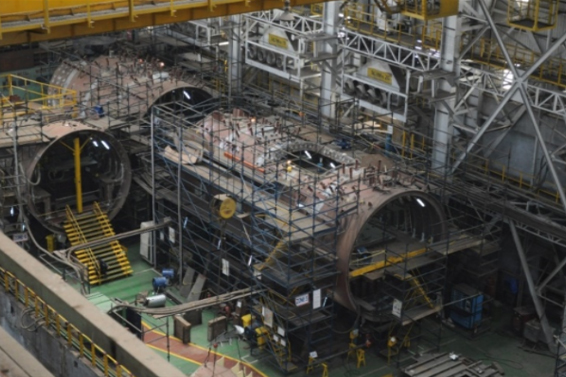AFI
SOURCE: AFI


India and Egypt’s strategic partnership continues to deepen, with a significant milestone marked by the arrival of an Indian Air Force (IAF) contingent in Egypt. The IAF contingent, comprising three Sukhoi Su-30MKI fighter jets, two C-17 Globemaster III heavy-lift transport aircraft, and one IL-78 aerial refueling tanker, along with 57 personnel, landed at Cairo West Airbase on November 26, 2024.
The IAF’s participation in the 8th Tactical Leadership Programme (TLP) scheduled from November 26 to December 27, 2024, underscores the growing defense cooperation between the two nations. This joint military exercise aims to enhance interoperability, tactical skills, and strategic understanding between the Indian and Egyptian Air Forces.
Continue readingSOURCE: AFI


Dr. G. Satheesh Reddy, Scientific Adviser to Raksha Mantri and former Chairman of the Defence Research and Development Organisation (DRDO), has hailed India’s groundbreaking achievement in developing and testing its first long-range hypersonic missile. Speaking on the sidelines of a defense event, Dr. Reddy revealed critical insights into this cutting-edge weapon system, describing it as a “game changer” in global missile technology.
Dr. Reddy clarified that the missile, tested successfully earlier this month, is not a conventional hypersonic cruise missile. Instead, it represents a novel hybrid design that combines the characteristics of both ballistic and cruise missiles. “This missile is launched like a ballistic missile and then transitions to cruise mode. No one in the world has it,” he emphasized.
Continue readingSOURCE: AFI


India’s RTA-90 (Regional Transport Aircraft) program, envisioned as a domestically developed 90-seater regional aircraft, represents a critical step toward self-reliance in the aviation sector. However, the development of such a platform requires expertise in design, manufacturing, and certification processes, areas where India’s civil aviation industry is still maturing. In this context, partnering with Embraer, a global leader in regional aviation, could be a game-changer for the RTA-90 program.
Embraer has decades of experience designing and manufacturing regional jets, including its popular E-Jet family, which has become a staple in the global regional aviation market. This expertise would provide invaluable insights into the RTA-90’s design and engineering processes, particularly in areas like aerodynamics, fuel efficiency, and passenger comfort.
Continue readingSOURCE: AFI


In a significant development highlighting the challenges of intellectual property (IP) rights protection, Chennai-based Zuppa Geo Navigation Technology has accused Chinese firms of infringing upon its autopilot technology. The company has urged the Indian government to act against imports from these Chinese entities to safeguard domestic innovation.
Zuppa Geo Navigation Technology, a pioneer in advanced navigation systems and drone technology, has written to the Directorate General of Foreign Trade (DGFT), seeking a ban on imports from Chinese firms allegedly involved in IP violations. The company claims that its patented autopilot technology has been infringed upon by two major Chinese companies JIYI Robot, a Shanghai-based firm exporting autopilots to India and CUAV, another Chinese company accused of supplying autopilot systems that allegedly violate Zuppa Geo’s copyright.
Continue readingSOURCE: AFI


For the first time in its history, the Indian Army has integrated civil helicopters into its logistics framework to bolster troop support, cargo delivery, and casualty evacuation in remote and inaccessible regions. This strategic partnership with Himalayan Heli Services marks a transformative shift in how the Army sustains operations in challenging terrains, particularly in the harsh winter months.
As per Army sources, the contract focuses on providing helicopter support to maintain winter cut-off posts along India’s Northern and Western borders. Over the course of a year, these civil helicopters will play a pivotal role in sustaining 16 remote posts in the Jammu region throughout the year. 28 posts in Kashmir and Ladakh during a critical 150-day period next year, when extreme snow and ice render traditional logistics routes impassable.
Continue readingSOURCE: AFI


The Aeronautical Development Establishment (ADE), a premier research and development laboratory under DRDO, has recently sent back a defective Long Range Electro-Optic (LREO) system, the IAI Tamam, to its Israeli manufacturer. This decision was taken after the unit encountered technical difficulties during flight trials.
The LREO system is a critical component of various UAV platforms, providing essential intelligence, surveillance, and reconnaissance capabilities. The unit’s malfunction has temporarily impacted the operational readiness of these platforms.
Continue readingSOURCE: AFI


Mazagon Dock Shipbuilders Limited (MDL), India’s premier shipbuilder, is set to participate in the 13th International Naval and Maritime Exhibition and Conference for Latin America (Exponaval 2024). The event, which is one of the largest naval and maritime exhibitions in the region, will take place in Valparaíso, Chile, from December 3 to December 6, 2024. MDL’s participation highlights India’s expanding defense industry and its growing footprint in the global maritime sector.
MDL will present its expertise in designing, building, and delivering a wide range of naval platforms. The offerings at Exponaval 2024 will include:
Continue readingSOURCE: AFI


The Indian Navy is at the forefront of technological advancement, actively pursuing the development of High-Power Microwave (HPM) weapon systems to bolster its maritime capabilities. These sophisticated directed-energy weapons harness the power of concentrated microwave energy to disrupt or destroy electronic systems in various targets, including drones and missiles. By emitting high-peak-power radio frequency waves, HPM weapons can instantly disable electronic components upon impact.
HPM weapons offer several advantages over traditional kinetic weapons. They enable rapid engagement, precise targeting, and extensive ammunition capabilities. Additionally, they require significantly lower power compared to kinetic weapons, making them an energy-efficient solution. These attributes make HPM weapons a crucial component of modern military strategies for countering emerging threats while minimizing collateral damage.
Continue readingSOURCE: AFI


EtherealX, a Bangalore-based aerospace startup, is making significant strides in the space launch industry with its ambitious project, the Razor Crest Mk-1. This fully reusable, medium-lift launch vehicle is designed to significantly reduce the cost of accessing space.
Recently, the company unveiled a render of its powerful Stallion engine, which is set to generate a staggering 925 kN of thrust. This engine will be the primary propulsion system for the Razor Crest Mk-1, propelling it into orbit.
Continue readingSOURCE: AFI


The Indian Army recently acquired 96 ATOR N1200 Specialist Mobility Vehicles (SMVs) manufactured at JSW Gecko’s newly established facility in Chandigarh, Punjab. This acquisition marks a significant step in indigenizing high-mobility, all-terrain vehicles, crucial for military operations in challenging terrains.
The ATOR N1200 is an indigenized version of the SHERP N1200, an amphibious extreme mobility vehicle designed by UK-based Copato Ltd. Copato has partnered with JSW Defence and JSW Gecko through a joint venture and technology supply license agreement to enable local manufacturing in India.
Continue readingSOURCE: AFI


History seems destined to repeat itself in the realm of India’s fighter aircraft procurement. The announcement that a Request for Proposal (RfP) for the acquisition of 114 Multi-Role Fighter Aircraft (MRFA) is “imminent” rings strikingly similar to the ill-fated Medium Multi-Role Combat Aircraft (MMRCA) tender of 2007. Valued at an estimated $20 billion, this is yet again projected to be the most expensive military acquisition in India’s history.
The MRFA tender bears an uncanny resemblance to the MMRCA process that began 17 years ago, aimed at procuring 128 fighters, with 108 to be manufactured in India. After a rigorous selection process, the Rafale emerged victorious in 2012, but the acquisition was scrapped in 2014 in favor of a direct purchase of 36 Rafale jets. This abrupt shift not only derailed the modernization of the Indian Air Force (IAF) but also sparked allegations of irregularities.
Continue readingSOURCE: AFI


The Indian Army is set to bolster its firepower with the acquisition of 200 new and upgraded Konkurs Missile Complexes, specifically designed for its fleet of BMP-2 Infantry Fighting Vehicles (IFVs). This development is part of ongoing efforts to modernise the Army’s armoured capabilities and ensure that its platforms remain combat-ready and effective in evolving battlefield scenarios.
The Konkurs-M, the latest iteration of the system, is a second-generation, semi-automatic, wire-guided anti-tank guided missile (ATGM) system. It is known for its reliability, precision, and capability to engage a variety of armored targets, including those equipped with reactive armor. The Konkurs system has been a staple in the Indian Army’s arsenal, and this acquisition reflects the Army’s confidence in its combat effectiveness and adaptability to modern threats.
Continue readingSOURCE: AFI


The Tejas Mk-II, also known as the Medium Weight Fighter (MWF), represents India’s ambitious leap in indigenous fighter jet development. Over the past decade, the program has undergone significant design modifications, reflecting evolving requirements and the pursuit of advanced capabilities to meet future combat challenges.
The first official mention of the Tejas Mk-II was made in 2009 by Ashok Baweja, then Chairman of HAL, during Aero India 2009. He described the project as a larger, more powerful derivative of the Tejas Mk-I, powered by a next-generation engine. Under P.S. Subramanyam, Director of the Aeronautical Development Agency (ADA), the vision expanded to include five squadrons with 70% indigenous content and a projected first flight in 2014.
Continue readingSOURCE: AFI


EndureAir Systems, a leading provider of innovative unmanned aerial vehicle (UAV) solutions, has achieved a significant milestone by successfully delivering its state-of-the-art Sabal 20 logistics drone to the Indian Army’s Eastern theatre. This marks a pivotal moment in advancing the Indian Army’s logistics capabilities, particularly in challenging terrains.
The Sabal 20, an electric unmanned helicopter, is designed to revolutionize aerial logistics. Its variable pitch technology empowers it to carry payloads of up to 20 kilograms, which is equivalent to half its weight. This impressive payload capacity, coupled with its scalable design, positions the Sabal 20 as a versatile tool for various military and civilian applications.
Continue readingSOURCE: AFI


In response to the escalating terror attacks in the Jammu region, the Ministry of Home Affairs (MHA) has taken a significant step by establishing a permanent National Security Guard (NSG) hub in the winter capital of Jammu and Kashmir.
This strategic move aims to bolster security and ensure rapid response to any major terrorist incident. The NSG hub, strategically located in Jammu city, will house a substantial number of elite commandos, sufficient to handle any emergency situation that may arise.
Continue reading